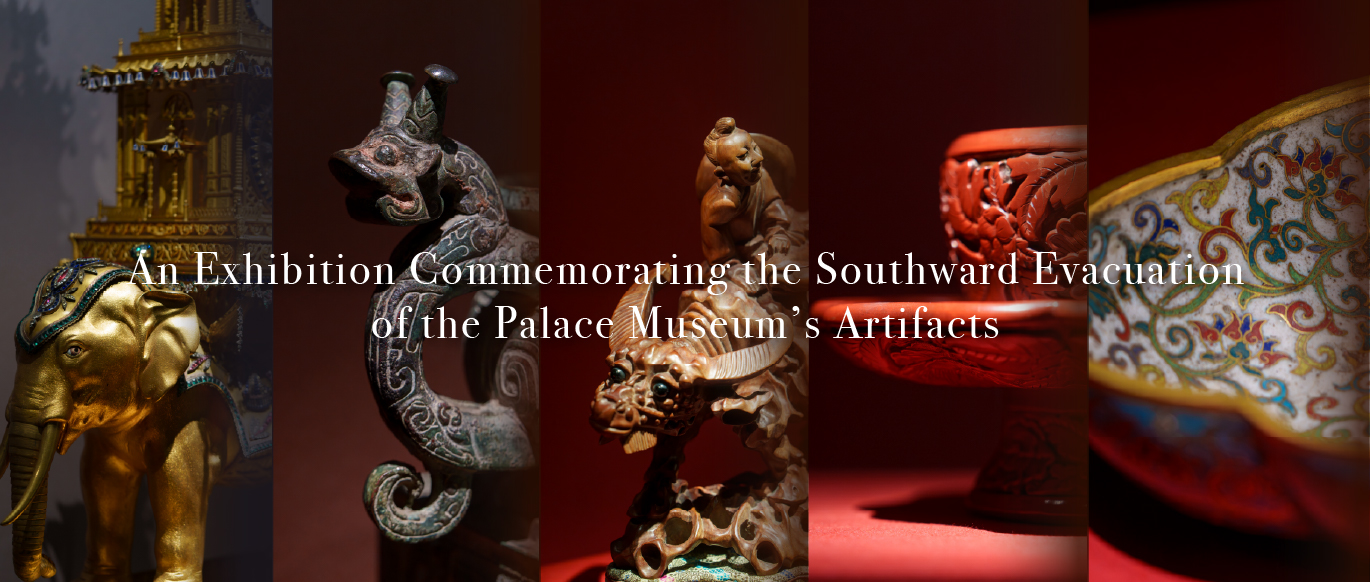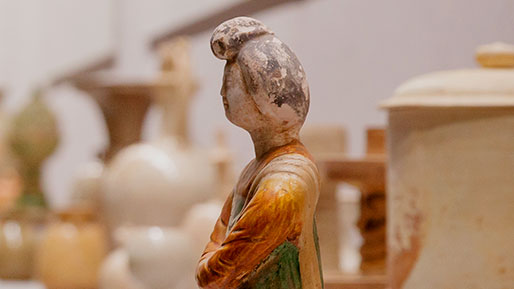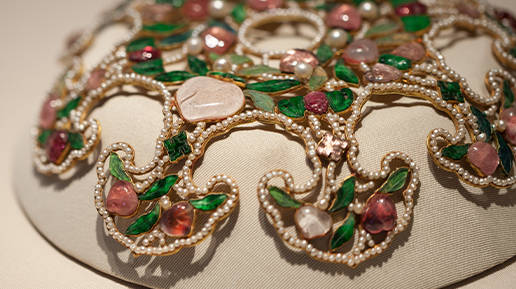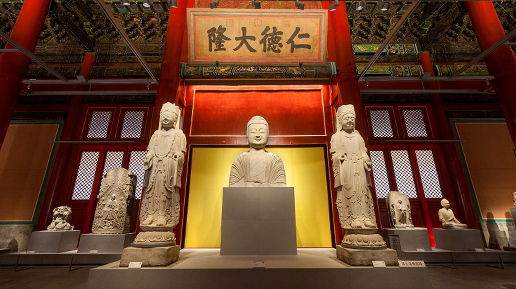“The World of Tea: Special Exhibition on Tea Culture” opened at the Wu men (the Meridian Gate) Exhibition Hall of the Palace Museum on Friday in Beijing. From September 2 to November 30, 2023, the exhibition welcomes the public to explore a curated collection of tea-related artifacts. Presented by the Palace Museum, an array of tea-related treasures sourced from 30 esteemed cultural institutions and museums, both domestically and internationally, are on display at the exhibition. With an impressive assemblage of 555 cultural relics, encompassing individual pieces and intricate sets, this exhibition illuminates the fascinating journey of Chinese tea civilization. Furthermore, it provides insights into this cultural phenomenon's origins, evolution, and remarkable achievements while emphasizing how tea has acted as a unifying thread connecting diverse regions and fostering the integration of various ethnic groups.
The exhibition's opening ceremony was held on Friday at the Baoyun Lou (Hall for Accumulated Treasures) of the Palace Museum. Distinguished guests included Wang Xudong, a member of the Party Leadership Group of the Ministry of Culture and Tourism and director of the Palace Museum; Rao Quan, a member of the Party Leadership Group of the Ministry of Culture and Tourism and vice minister of culture and tourism; Guan Qiang, a member of the Party Leadership Group and deputy administrator of the National Cultural Heritage Administration; Shan Jixiang, president of the Chinese Society of Cultural Relics and former director of the Palace Museum; Liu Yuzhu, chairman of the China Foundation for Cultural Heritage Conservation; Liu Zhonghua, an academician with the Chinese Academy of Engineering and a professor at Hunan Agricultural University; Fung Ming Chu, former director of the Taipei Palace Museum; Lin Zhongyue, chairman of the Cross-Straits Tea Exchanges Association; and Cheng Pei-kai, former chairman of the Hong Kong Intangible Cultural Heritage Advisory Committee. Representatives from participating exhibitors, officials from cultural and museum departments in Beijing, representatives from societies, associations and foundations, experts and scholars, and leaders of the Palace Museum also attend the opening ceremony. Wang Xudong, director of the Palace Museum; Sergei Nilov, head of the Department of Russian Culture and History of the Russian State Hermitage Museum; Li Yun, executive vice president of China Construction Bank; and Song Yao, vice president of the Longfor Group and vice chairman of Longfor Foundation, all delivered speeches. Kang Hui, a well-known Chinese TV host, presided over the opening ceremony.
In November 2022, the United Nations Educational, Scientific, and Cultural Organization (UNESCO) acknowledged Chinese traditional tea processing techniques and their associated social practices in its intangible cultural heritage list. This noteworthy recognition marks a significant stride in promoting Chinese tea culture and facilitating deeper cross-cultural exchanges and mutual learning.
To further these objectives, the Palace Museum has organized "The World of Tea: Special Exhibition on Tea Culture." This exhibition seeks to advance the systematic protection of intangible cultural heritage, stimulate innovative developments in China's rich traditional culture, and fortify the bonds within the Chinese nation while showcasing the allure of Chinese culture on a global scale. Through the medium of this exhibition, the Palace Museum delves into the depths of tea history, explores the intricacies of the tea ceremony, and celebrates the diversity of tea-related activities. Using tea as a conduit, it elucidates the essence of Chinese tea culture, which greatly emphasizes the values of harmony and unity.
Tea originated in China and is popular worldwide. Legend has it that the Chinese were already aware of and making use of tea during the era of Shennong (who is considered the first Yan Emperor and an ancestor of the Chinese people). In Zhejiang Province, roots of artificially cultivated tea trees dating back about 6,000 years have been discovered. In Shandong Province, remains of boiled tea leaves dating back about 2,400 years were discovered in ancient tombs from the Warring States Period (476-221 BC), making it the oldest known evidence of tea drinking. Since the Han Dynasty (202 BC-220 AD), the tea preparation and drinking methods were diversified, including eating, frying, whisking, boiling, and steeping. Drinking tea has evolved into a cultural activity that sates an aesthetic thirst. The Chinese have combined their thoughts on life, the nation, nature, and the universe with daily practices, forming the essence of tea culture. The widespread embrace of tea within China has acted as a catalyst, promoting interactions among people from diverse regions and ethnic backgrounds who all share a deep affection for this cherished beverage. Furthermore, the global dissemination of tea has acted as a conduit for cultural fusion across the vast expanse of the Eurasian continent.
The exhibition delves into tea culture and fully presents the development of Chinese civilization and its interactions with other civilizations, all through the lens of tea as a medium. The exhibition comprises four sections, each illuminating a distinct facet of tea's rich history and cultural significance.The first section explores the origins of tea in China, tracing its development over thousands of years and its pivotal role in politics, economics, and cultural exchanges. On display are cultural relics from the Qing Dynasty (1644-1911), including preserved tea leaves, export paintings, and combinations of various objects. The second section delves into the essence of the tea ceremony, featuring a collection of notable paintings and calligraphy from the Palace Museum, as well as ancient texts and excavated tea sets. In the third section, the exhibition traces the global spread of tea from China to various parts of the world, highlighting how different cultures adopted and adapted tea culture. Exhibits include exquisite tea sets from the UK, Japan, and Russia, unique tea sets used in the Qing Dynasty court, and foreign-style tea sets produced by the Imperial Workshop of the Qing Dynasty. The fourth and final section discusses the enduring appeal of tea culture, emphasizing its diverse and integral role in people's daily lives across the globe. Rooted in tradition, it showcases tea culture's ongoing development and prospects.
The exhibition spans from the Neolithic Age to the present day. It highlights the development and adoption of tea culture over thousands of years, as well as its embodiment of Chinese philosophical ideals such as unity of nature and man and universal harmony. The exhibits include ancient green-tea tree roots unearthed from the Tianluoshan site of the Hemudu culture (about 5000 BC to 4000 BC) in Yuyao, Zhejiang Province, pushing back the timeline of tea planting in China to about 6,000 years ago. Tea bowls and remains of boiled tea leaves were unearthed from a tomb of the Warring States Period in Zoucheng of Shandong Province, making it the oldest known evidence of tea drinking. The exhibition also features unearthed tea leaves from the Han and Song (960-1279) dynasties, along with over 40 pieces or sets of tribute tea (Gong Cha in Chinese) from the Qing Dynasty collected by the Palace Museum. Together, these cultural relics document China’s over 6,000-year history of tea cultivation and utilization. On display for the first time, a complete set of tea wares unearthed from a Tang Dynasty (618-907) tomb in Qujiangzhuang of Changzhi City, Shanxi Province, in 2022 is one of the most recent archaeological discoveries reflecting Tang Dynasty tea culture. The painting Spring Banquet illustrates a gathering of literati around a rectangular banquet table, with tea-related tools such as tea spoons and tea cups on it, offering a snapshot of how Song Dynasty literati enjoyed tea. A painted clay sculpture of the “Tea Sage” Lu Yu, originally displayed in the Emperor Qianlong’s tea room in Chengde Mountain Resort, is also featured. Accompanying this sculpture are tea sets and a statue from the Tang Dynasty unearthed in Gongyi, Henan Province. The statue is believed to be a representation of Lu Yu. From the Tang to the Qing Dynasty, the once-in-a-millennium meeting of two statues of Lu Yu is unprecedented in the history of tea culture.
This exhibition features a total of 555 pieces or sets of exhibits, including 227 from representative collections of 30 cultural institutions and museums both domestically and internationally. These collections are sourced from esteemed institutions such as the National Library of China, the National Museum of China, the China National Tea Museum, the Institute of Archaeology of the Chinese Academy of Social Sciences, the Museum of Ethnic Cultures of Minzu University of China, the Management Center of Ming Tombs in Beijing’s Changping District, the Shanghai Museum, the Tianjin Library, the Museum of Heilongjiang Province, the Hebei Provincial Institute of Cultural Relics and Archeology, the Xinjiang Uygur Autonomous Region Museum, the Shaanxi Academy of Archeology, the Famen Temple Museum, the Hanyangling Museum, the Gongyi Museum, the Shandong University Museum, the Changzhi City Cultural Relics Protection Research Center (Changzhi City Archaeological Research Institute), the Xiyang County Cultural Relics Institute (Xiyang County Museum), the Hunan Provincial Institute of Cultural Relics and Archeology, the Hunan Museum, the Nanjing Museum, the Guizhou Provincial Museum, the Zhejiang Provincial Institute of Cultural Relics and Archeology, the Guangdong Provincial Museum, the Shaowu Museum, the Opium War Museum, the Russian State Hermitage Museum, the British Victoria and Albert Museum, and the Tokyo National Museum and the Idemitsu Museum of Arts in Japan.
“The World of Tea: Special Exhibition on Tea Culture” comes with an exhibition catalog. Simultaneously, the Palace Museum's official website will initiate online exhibition tours. Moreover, multiple channels and formats will be adopted to promote the exhibition, including the museum’s official accounts on Weibo, WeChat, and online video platforms. The Palace Museum will sequentially present a series of public academic lectures to facilitate visitors to understand the exhibition. Please stay tuned for lecture announcements on the “The Palace Museum Publicity and Education” official WeChat account.
During the exhibition, a tea-related cultural and creative products experience space is open to visitors at the Chonglou (the Lofty Pavilion) in the northeast of Wu men (the Meridian Gate). This unique space is a dedicated area for cultural and creative exploration, highlighting the essence of tea culture within the Forbidden City, with a theme centered around "thousands of feet of snow." By seamlessly integrating elements such as white jade carving, meticulous mortise and tenon craftsmanship, and the iconic red wall color, visitors are invited to fully immerse themselves in the captivating allure of traditional Chinese culture while indulging in a profound tea culture experience.
China Construction Bank, as the joint promoter of the exhibition, and Longfor Group, as the public welfare supporter, have collaborated to support the exhibition activities. During the exhibition, the Palace Museum and China Construction Bank will launch the fifth round of new precious metal cultural and creative products – the “Divine Animals of the Forbidden City.”
Admission to this exhibition is free with a Palace Museum ticket, and visitors can make real-name reservations through the "Palace Museum" WeChat mini-program.








